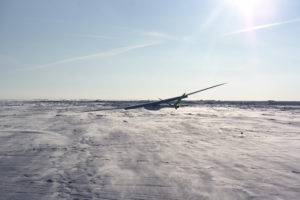Today at 10 local time we finalized our first Intensive Observational Period after 22 hours of high activity. We captured an interesting case of a wintertime boundary layer transition, starting with air temperatures of -3 C at noon of February 10 that gradually decreased to close to -10 C towards the end of the IOP. Over the same time surface winds dropped from 15 to 5 m/s.
Our ground based instrumentation worked stable and reliable over the whole period, except for a microphone failure on the vertically pointing FMI sodar. Luckily this was detected after a short downtime and Andrew and Line could fix it in a night repair based on detailed email instructions by Rostislav.
The tentative schedule for the UAV operations was to perform a 24 hours flight program, with SUMO profiles to 1800 m and MASC turbulence profiles between the surface and 150 m every 6 hours, complemented by hourly lower level profiles (200-300 m) measured in turn between the CopterSonde from Oklahoma and the Bergen bebop2met. The high wind speed in the beginning (the first SUMO profile flight at 12 UTC had to be terminated at an altitude of 700 m at a wind speed of 20 m/s), partial icing conditions a few hundred meters above the ground, and later on the increasing tiredness of pilots and ground control station operators resulted in some modifications of the original plan.
Nevertheless we reached an overall very good UAV coverage during IOP1. OU performed a total of 16 CopterSonde profiles, reaching altitudes between 300 and 1200 m above ground. UT flew more than 4 hours of staggered race track patterns for the determination of turbulence parameters and UiB contributed with 4 SUMO profiles to 1800 m and 7 bebop2met profiles up to 300 m.




